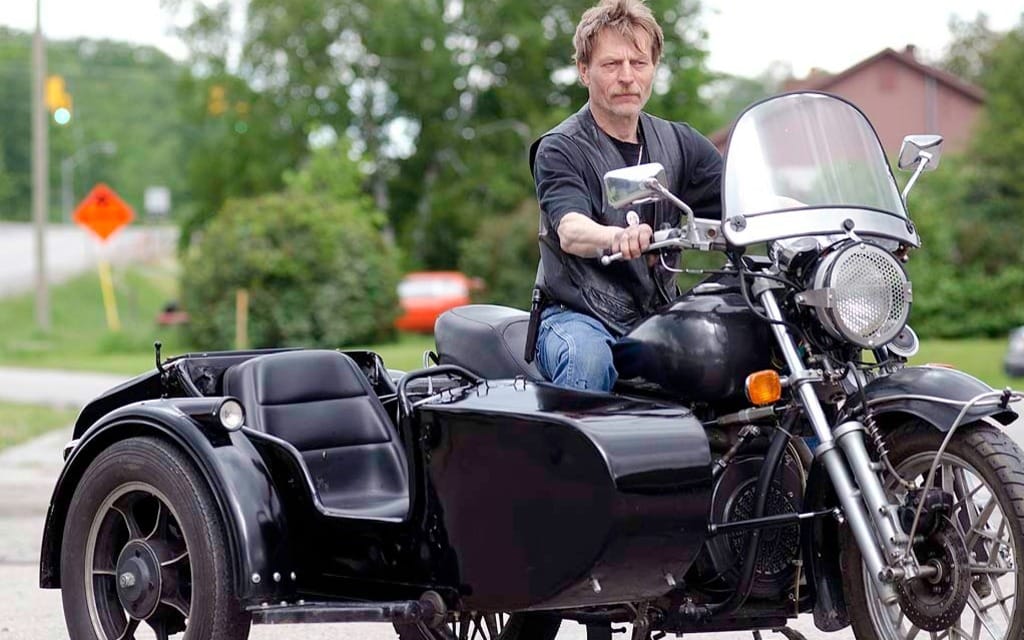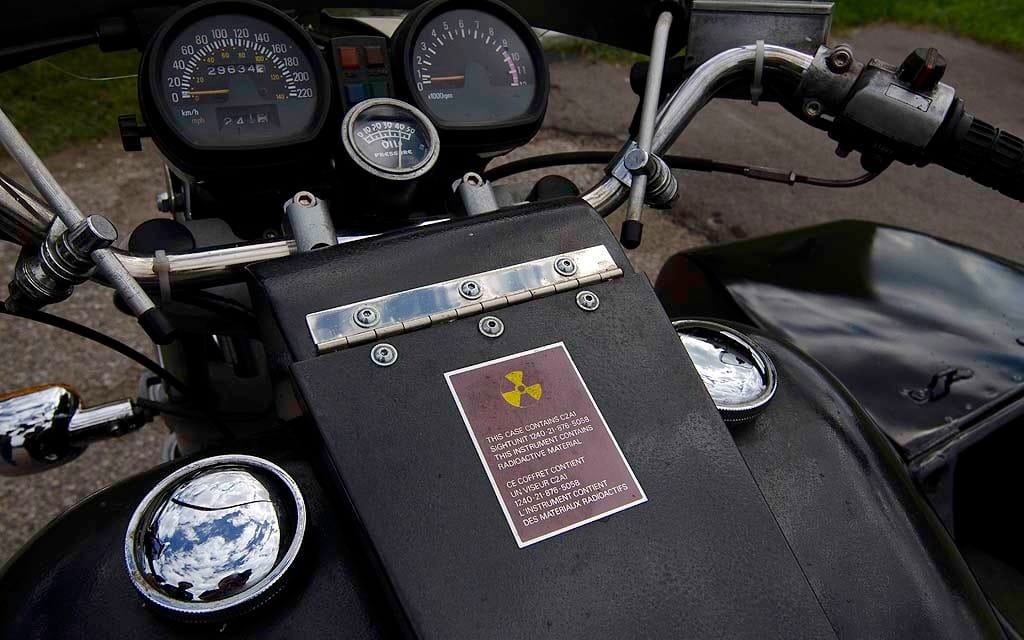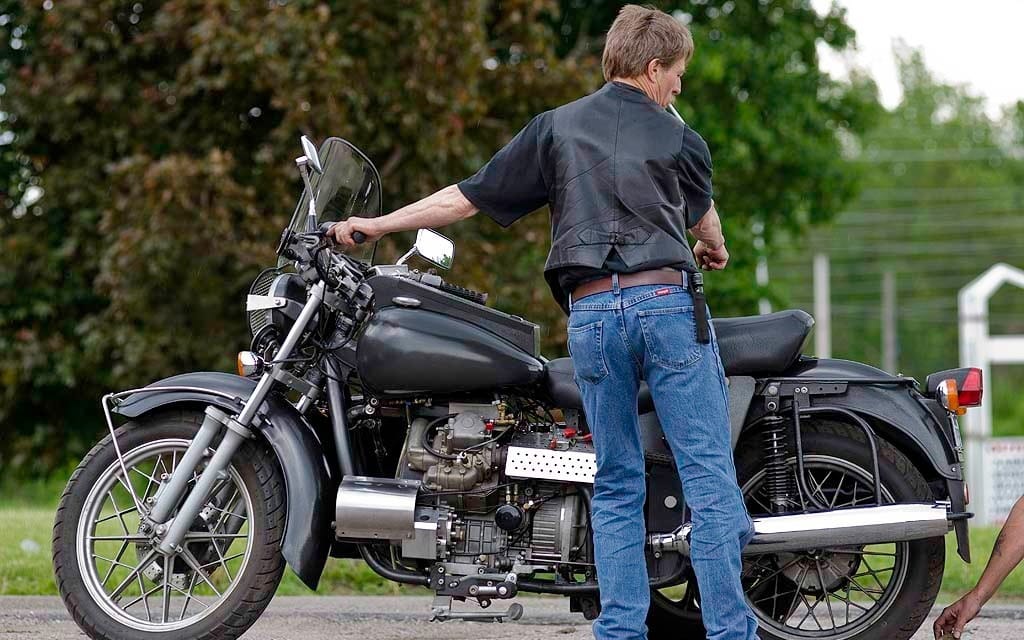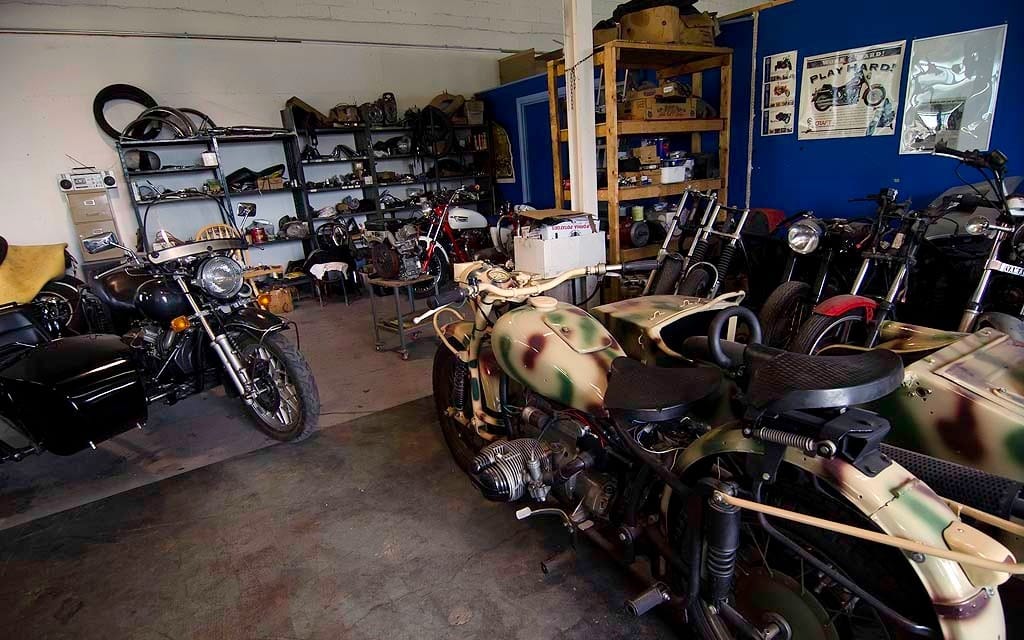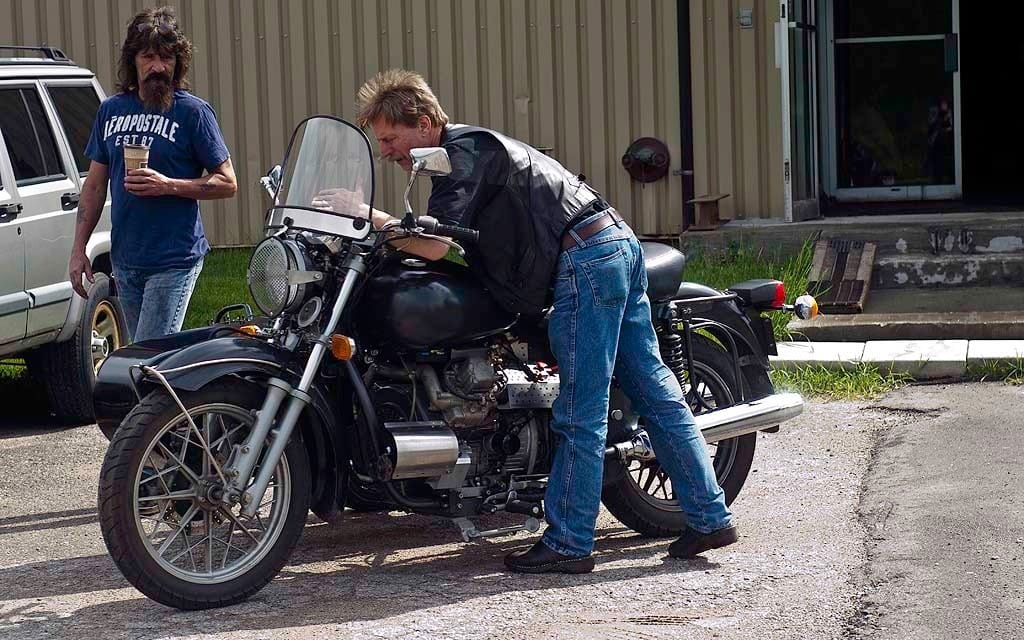Sweet smell of success
Apart from a solar energy panel on the back of the sidecar and a notice on the toolbox that it contains radioactive material, there’s not so much to tell you that this BMW is any different from one that, say, a Wehrmacht Oberleutnant might have used to visit a Parisian brothel on a fine August night in 1941. With a nice Bordeaux in the sidecar, if he was any good.
That German army lieutenant might be alarmed by the sound of the engine, which at first has the ringing clash of a jackhammer pounding a steel plate, but soon it settles down to a friendly diesel paddumpa-rumpa. And if he catches a whiff of the exhaust gas, he may just pull over to grab some French fries for nibbling with that wine. After all, he’s in Paris.
Our WWII motorcyclist would be surprised to learn that the BMW he’s riding is powered by an engine made in China, and he’d be shaken by news that the motorcycle was built by a Canadian-German machinist in the town of Midland 70 years in the future.
Eckhard Schulz probably didn’t imagine that it would be a part of his personal future when he acquired the basket-case R80 in Manitoba 10 years ago. It was more or less complete, but the engine was ruined. As a sideline, Schulz runs Eco Classic Motorcycles with partner Greg Cronk in a Midland shop space cluttered with motorcycles and parts of motorcycles. He picks them up the way some guys pick up bad habits: he doesn’t appear to know how to get rid of them, and they consume a lot of his time. Just look around. Behind a two-wheel-drive Dnepr with camouflage paint and a hinged blackout shade, half a dozen motorcycles are lined against the wall in various stages of undress, including a flathead-engined Molotov from Siberia with a BMW drive; motorcycle frames hang from ceiling racks, exhaust pipes and wheels and seats and fuel tanks collect dust on shelves and in corners. But you have the feeling that it’s organized, that he could lay his hands on an R68 brake housing after a brief head scratch and a quick shuffle across the shop floor in those leather clogs.
Here in the corner is a Triumph T100 with a T140 front end (“because I didn’t like the old front ends”), all done up in red and white and nearly finished, and on tables behind the Afghan war Dnepr are glossy BSA and Triumph frames waiting for their engines. The shop’s purpose isn’t collecting, but restoring and even transforming, and the project that I have come to see on this cloudy day is a 1984 BMW R80 that has been transformed into a diesel-powered sidecar rig.
Unfortunately, despite Schulz’s organizing proficiency, he forgot to figure out the width of the motorcycle and sidecar attachment before he built it, inside the shop. He’s a lucky man, though, so the assembled Beemer and sidecar can be wiggled through the door with about an inch to spare on either side. Maybe that’s to be expected: he’s the sort of engineer who gets work done by eye-balling things and holding a wet finger in the air. On one side of the shop are metal lathes and other powered tools that he uses to produce bags of pigtail brass and steel shavings. He says no-thanks to computer-aided design techniques, but the things he makes fit his intentions like a bullet fits a barrel. There’s a clutch bell housing sitting on a table; it’s got the jewel-like finish of something you’d find on a Milwaukee engine assembly line, but he made it in his Midland shop to join the BMW R80 five-speed transmission to the Chinese 800 cc V-twin diesel engine. Curious fact: the bolts in this diesel engine are metric, but their spacing pattern is in inches. Somehow, here, that seems fitting.
Schulz gets the sidecar rig squeezed through the door and onto the parking lot in front of the shop just as a light rain starts to fall. The bike has a left-side kickstarter, but the exhaust pipe under it gets in the way of its action; he’s going to modify the lever, but for now the electric starter is a necessary convenience. It’s a shame about that rain, though. If I had come up the day before, as we’d planned, we’d be nice and dry. But the original starter—that is, the Chinese one—was crap, so he installed another one. He acquired it from a Volkswagen Passat, but then he had to carve some metal to hold the German starter on the Chinese engine, and that took a little extra time, which is why on this day we’re standing in the rain while he fiddles with the diesel engine, which will not start. Not because of the starter, though—it’s fine. There’s a blown fuse.
With Greg Cronk’s help, he gets the fuse replaced (it takes him nearly half an hour!) and as I stand at a safe remove, the engine fires up with the crash of hammers on steel. The Harley-Davidson mufflers that a friend donated, brand new, are doing little to suppress the noise, and when he adjusts something and the engine’s concussive bark softens, I’m relieved. A light puff of smoke emits from the Harley pipes, smelling like the back door of a restaurant. He gets in, shifts into reverse, backs up, then shifts again and roars across the empty parking lot, not quite lifting the sidecar wheel when he turns. Smoke issues from those chromed mufflers, but that will go away when the engine is thoroughly warmed. For the moment, it looks like any other BMW sidecar rig being piloted by a cigarette-smoking, bare-headed middle-aged German in clogs.
I clamber into the sidecar, and away we go down Midland’s empty streets, illegally riding without helmets or any other items of safety gear, and we’re making left turns, so the sidecar remains safely planted. After three or four spins around the block, we pull back in to the parking lot, unscathed. The bike is surprisingly smooth, and the sidecar ride is comfortable enough that I can take pictures. With the bike stopped, we trade positions, and then I power it down the parking lot. The gear shifter, which he has modified, works in reverse direction, so it’s back on the heel-pad for first, then down on the toe-shifter for second and third. It’s a race-pattern gear shifter, and I don’t know why I’m surprised by that.
The bike pulls with a lethargic insistence that feels big and strong. There’s almost no horsepower, but the revs don’t need to rise above 3,500 rpm for a full load of torque, and I notice little change in acceleration when I step down into second, then third. Despite what must be 400 kilos of mass, the motorcycle-and-sidecar rig steers easily in both directions, and we make it down and then chuff back up the long parking lot to the shop, where a heavy application of brake lever eventually kills forward motion. He tells me to use the rear pedal next time; the bike is capable of highway speeds, and the brakes are, he insists, adequate for that.
I get off the bike, and he climbs out of the sidecar. I want to take some pictures, so he moves it into a better location, leaves it quietly idling, and goes for a smoke with Cronk. The diesel engine could run all day, he tells me. It’s air-cooled, with a large fan that resides in front, where you’d see a radiator on a liquid cooled bike, and it just won’t overheat, ever.
So, that’s nice, but what’s the point? Surely this concoction of BMW frame and transmission, Chinese engine, Yamaha fork, Kawasaki fork, Harley-Davidson fuel tank and mufflers, Yamaha seat, and Volkswagen starter, all of it stirred together with a shiny batch of hand-made fittings—surely all this has a purpose! After all, this project represents about 75 weekends and a lot of nights. So before all this, before we ride it, before he gets the fuse replaced and I hear it jackhammering, before he shows me the T-100/140 Triumph and the Siberian flathead and the “Dnepr that became a BMW R75 Afghan war bike” and the clutch bell housing that he turned on his lathe, I ask him: Why?
“I just wanted to find an alternative,” he says, his German accent still noticeable 33 years after. “Yes, there is a lot of power source, out there, it is not being used. In Europe, they use it. Why don’t we do … something? There are people in the States, they built similar things. I mean, you go on the Internet, and you find, worldwide, you find diesel motorcycle, and you know, you drive a Harley, you can drive this tractor.” He laughs. “You know, it’s the same thing!”
Then he tells me a story. Three years ago, he found this diesel engine in China. A V-twin, 800 cc diesel, maybe designed in Australia but probably made at factories all over China. He called the exporter and they sold him two for $1,000. The shipping charges would more than double that fee. The engines arrived, and they were good, but they were bare engines. To work in a motorcycle they would need clutches, transmissions, fuel sources, frame structures, and throttles. Some of those things he would take from the donor R80, and some he would make up. Schulz is a smart person and a very capable millwright and machinist. He works at Raytheon Elcan Optical Technologies in Midland, a company that produces optical devices (like electronic gunsights and aircraft cockpit lenses) for military use, among other things, so his day job is interesting. With the BMW frame and transmission and the Chinese engine, he had a starting point on a project for his weekend job.
The engine was not built to be put into a BMW frame, so he made a cradle for it, gave it rubber mountings, mated it to the frame, and secured the engine into it with just four bolts. He hooked up a four-speed transmission from an older BMW, but it broke, so he made up a clutch assembly for the R80’s five-speed transmission and attached that. The original starter broke, and we know what he did about that.
If it was just a diesel-powered motorcycle, he might have finished it at that, but he wanted to make a sidecar rig, so he needed to consider suspension—you can’t have a motorcycle that dives under braking if you’ve got a sidecar attached to it, so sidecar rigs generally use a leading link fork, which prevents that front-end diving reaction. He had a 750 Yamaha fork, and a Kawasaki 440 fork, so he made a harness that would hold the Kawasaki’s lower fork tube in line with the Yamaha’s, and made a link to attach the front wheel. Result, one ersatz leading link fork.
They like their chips at Elcan, so the cafeteria there uses a lot of frying oil. The company paid good money to have that oil recycled, but he offered to save them the expense. No, he wouldn’t sell the oil; he would burn it in his motorcycle. The diesel engine will burn just about anything, it turns out, though running on lard is a bit of a slog.
So he gets the oil for free, and there’s a lot of it. But you don’t want a motorcycle that burns only fryer oil; on a cold day, the stuff is hardly a liquid. You want to be able to burn regular diesel fuel to get things going, then let the engine’s heat exchanger (not yet built, but it’s coming) warm the Mazola and lower its viscosity so it can feed the engine, which uses direct injection. A Harley-Davidson split fuel tank went on the bike, allowing him to store both energy sources and switch from one to the other. (On this day, it’s warm despite the rain, so he starts it and runs it on the fryer oil.)
The H-D fuel tank is wide, and instead of leaving a gap between left and right halves, he built a toolbox to go in there, and because he works at Elcan, he has access to things like radiation warning decals, which he placed on the box lid and which may help to deter thieves who bother to read it. Because the fuel tank is so wide, he thought the skinny Yamaha fork looked wrong, so he machined new triple trees out of T60-61 aluminum and widened the fork to 10 inches. Now it looks properly wide-glide. Most of the ties that hold the sidecar to the bike are stock items, but he did make up one, and because the diesel engine’s electrical output is not high enough to keep the battery fully charged when lights are used, he attached a supplementary charger to the sidecar, powered by sunlight.
That electrical insufficiency kept him from making any real journeys in the sidecar rig last year, but he did ride it, legally, on the roads around Midland. It’s registered as a BMW R80 and has the frame numbers to prove it. And if made-in-China is not part of BMW’s present, well, the future’s coming, baby. And it might just smell like French fries. His BMW diesel sidecar is a prototype, he says, a proof of concept. If there are paying customers, there will be more Eckhard Schulz diesel motorcycles. And if the thrill of the unusual isn’t enough to convince a customer, he’s got one other trick up his sleeve: free fuel. “If someone is interested in having one built, I’ll give them fuel for free. As much as they can take.”
